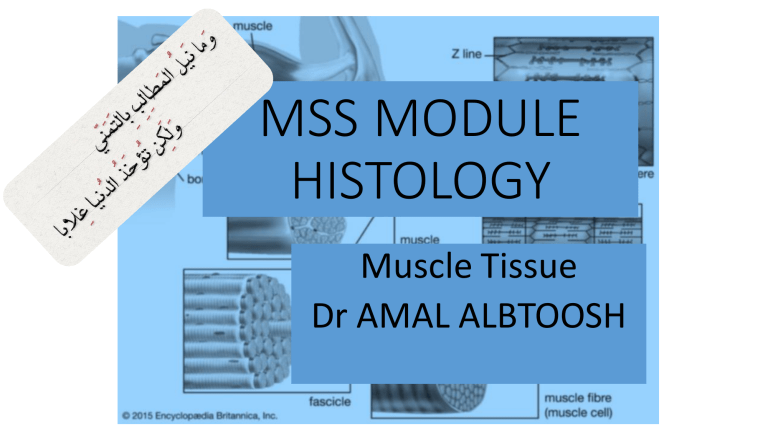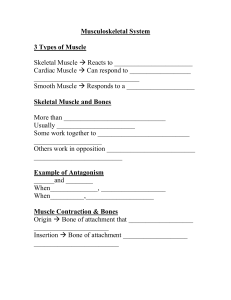
MSS MODULE HISTOLOGY Muscle Tissue Dr AMAL ALBTOOSH Muscle Tissue ❖ Despite its complexity, the human body is composed of only FOUR BASIC TYPES OF TISSUE: EPITHELIAL, CONNECTIVE, MUSCULAR, AND NERVOUS. ❖ Muscle tissue is composed of cells that optimize the universal cell property of contractility . ❖ Three types of muscle tissue can be distinguished on the basis of morphologic and functional characteristics, with the structure of each adapted to its physiologic role. ❖ In all types of muscle, contraction is caused by the sliding interaction of thick myosin filaments along thin actin filaments. MUSCLES’ RELATED TERMS ❑The cytoplasm of muscle cells is often called sarcoplasm (Gr. Sarkos: flesh + plasma: thing formed) ❑The smooth ER is the sarcoplasmic reticulum, and the muscle cell membrane and its external lamina are the sarcolemma ( sarkos + Gr. lemma , husk). ❑Most terms related to muscles start with or contain: myoExamples: myoplast, myotube. epimyisum ■ Cardiac muscle: ✓ cross-striations ✓ composed of elongated, often branched cells bound to one another at structures called intercalated discs that are unique to cardiac muscle. ✓ Contraction is involuntary, vigorous, and rhythmic. ■ Smooth muscle consists of: ✓ collections of fusiform cells that: ➢ lack striations ➢ have slow, involuntary contractions. Macroscopic Muscle Structure Connective tissue investments : ✓ An ENTIRE SKELETAL MUSCLE (such as the biceps) is surrounded by a thick connective tissue known as the EPIMYSIUM: which forms aponeuroses that connect skeletal muscle to skeletal muscle, and tendons that connect skeletal muscle to bone. ✓ FASCICLES (small bundles of muscle cells)are surrounded by a PERIMYSIUM. ✓ whereas individual SKELETAL MUSCLE CELLS are surrounded by an ENDOMYSIUM composed of reticular fibers and an external lamina. ■ Skeletal muscle contains bundles of very long, multinucleated cells with cross-striations. Their contraction is quick, forceful, and usually under voluntary control. ❯ SKELETAL MUSCLE ✓ Skeletal (or striated ) muscle consists of muscle fibers, which are long, cylindrical multinucleated cells with diameters of 10 to 100 μm. ✓ Elongated nuclei are found peripherally just under the sarcolemma, ✓ a characteristic nuclear location unique to skeletal muscle fibers/cells. ✓ A small population of reserve progenitor cells called muscle satellite cells remains adjacent to most fibers of differentiated skeletal muscle. ✓ ❑ ❑ ❑ ❑ • • • • Types of skeletal muscle cells include: RED (TYPE I), distinguished by its slow contraction and its ability not to fatigue easily; WHITE (TYPE IIb), which contracts rapidly but fatigues easily; INTERMEDIATE (TYPE IIa) with characteristics that resemble both types I and IIb. These three cell types differ from each other in their content of: myoglobin ( a protein that is similar to hemoglobin in that it binds 02) number of mitochondria concentration of various enzymes, and rate of contraction A change in innervation can change a fiber's type: If a red fiber is denervated and its innervation is replaced with that of a white fiber, the red fiber will change its characteristics and will become a white fiber Skeletal muscle cross-striations 1. A bands are anisotropic with polarized light; they usually stain dark. They contain both thin and thick filaments, which overlap and interdigitate. Six thin filaments surround each thick filament. 2. I bands are isotropic with polarized light and appear lightly stained in routine histologic preparations. They contain only thin filaments. 3. H bands are light regions transecting A bands; they consist of thick filaments only. 4. M lines are narrow, dark regions at the center of H bands formed by several cross-connections ) M-bridges) at the centers of adjacent thick filaments. 5. Z disks (lines) are dense regions bisecting each I band. The basic contractile unit of the skeletal muscle cell is the sarcomere Triad of skeletal muscle: Tubular invaginations, T tubules (transverse tubules), of the muscle cell membrane penetrate deep into the sarcoplasm and surround myofibrils in such a manner that at the junction of each A and I band these tubules become associated with the dilated terminal cisternae of the sarcoplasmic reticulum (smooth endoplasmic reticulum), forming triads. SPECIALIZED DIFFUSE RECEPTORS 1. Specialized diffuse receptors, dendritic nerve endings in the skin, fascia, muscles, joints, and tendons, respond to stimuli related to deep touch, pressure, temperature, pain, and proprioception. 2. These receptors are specialized to receive only one type of sensory stimulus, although they will respond to other types of stimuli provided that the stimulus is sufficiently intense. 3. They are divided morphologically into free nerve terminals and encapsulated nerve endings, which are ensheathed in a connective tissue capsule. Sensory receptors may be categorized into three groups: ❑ EXTERORECEPTORS, which access information from the OUTSIDE ENVIRONMENT. ❑ PROPRIOCEPTORS, which access information from MUSCLES, TENDONS, AND JOINT STRUCTURES; ❑ INTEROCEPTORS, which access information from within THE INTERNAL ENVIRONMENT. The type of INFORMATION received is also a manner of classification of receptors: ➢ MECHANORECEPTORS Four major types of mechanoreceptors are specialized to provide information to the central nervous system about touch, pressure, vibration, and cutaneous tension: Meissner's corpuscles, Pacinian corpuscles, Merkel's disks, and Ruffini's corpuscles ➢ THERMORECEPTORS are activated by either heat or cold. ➢ NOCICEPTORS, also known as pain receptors, are activated by stimuli that are painful such as extreme temperatures that are hot or cold enough to cause damage to the tissues, pressure, or touch that are intense enough to cause damage to the tissues. Proprioceptive receptors are of two types, muscle spindles and Golgi tendon organs The muscle spindle (neuromuscular spindle) is an elongated, fusiform sensory organ within skeletal muscle that functions primarily as a stretch receptor Proprioceptive receptors are of two types, muscle spindles and Golgi tendon organs The GTOs, composed of encapsulated collagen fibers that are surrounded by terminal branches of type lb sensory nerves, are located in tendons, where they counteract the effects of muscle spindles



